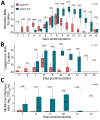Extended Viral Shedding of MERS-CoV Clade B Virus in Llamas Compared with African Clade C Strain
- PMID: 36823022
- PMCID: PMC9973703
- DOI: 10.3201/eid2903.220986
Extended Viral Shedding of MERS-CoV Clade B Virus in Llamas Compared with African Clade C Strain
Abstract
Middle East respiratory syndrome coronavirus (MERS-CoV) clade B viruses are found in camelids and humans in the Middle East, but clade C viruses are not. We provide experimental evidence for extended shedding of MERS-CoV clade B viruses in llamas, which might explain why they outcompete clade C strains in the Arabian Peninsula.
Keywords: MERS-CoV; MERS-CoV clade C; Middle East respiratory syndrome coronavirus; Spain; camelid; llama; virus transmission; viruses.
Figures


References
-
- World Health Organization. MERS situation update—August 2021. [cited 2022 Jun 15]. https://applications.emro.who.int/docs/WHOEMCSR451E-eng.pdf
-
- Food and Agriculture Organization Of the United Nations. MERS-CoV situation update. 2021. [cited 2022 Jun 15]. https://www.fao.org/ag/againfo/programmes/en/empres/mers/situation_updat...
Publication types
MeSH terms
LinkOut - more resources
Full Text Sources

